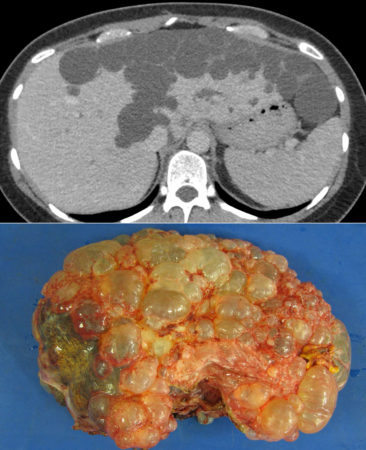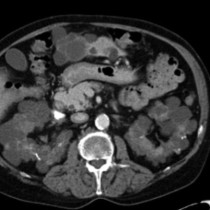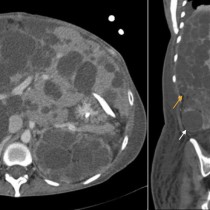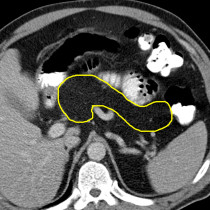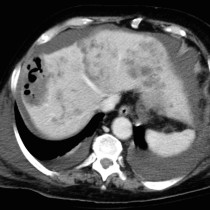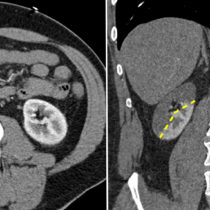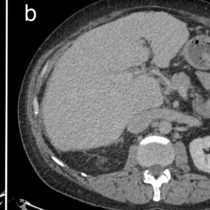Polycystic liver disease
This 40-year-old woman presented with upper abdominal pain. An abdominal ultrasound was arranged and showed a large number of cysts in the liver.
Subsequent CT, shown here, demonstrates multiple cysts of varying sizes, predominantly involving the left lobe of the liver. This patient also had multiple cysts in both kidneys.
These are the appearances of polycystic liver disease. As the patient was very symptomatic, a left hemihepatectomy was performed. The resected left lobe is shown here, and correlates nicely with the CT image above it.
Polycystic liver disease is a hereditary, autosomal dominant condition that is more common in women and, in around half of patients, is associated with polycystic kidney disease, as in this case. The majority of patients are asymptomatic however in some cases the cysts cause abdominal pain, distension, or early satiety (due to mass effect on the adjacent stomach). Rarely, the condition can cause hepatic failure and portal hypertension. Patients may also present with acute abdominal pain due to haemorrhage into a cyst, or rupture of a superficial cyst into the peritoneal cavity.
As hepatic cysts are a very common incidental finding at imaging, and many people have multiple cysts, to consider a diagnosis of polycystic liver disease at least 20 cysts need to be present. The cysts in polycystic liver disease can vary in size from 1 mm to over 10 cm, and the cysts often replace more than 50% of the hepatic parenchyma. They are usually of fluid density on CT (around 0 Hounsfield Units), however it is not unusual for one or more of the cysts to contain higher density material due to previous haemorrhage. Occasionally, the cyst walls can be calcified.
Treatment options for symptomatic patients range from ultrasound-guided aspiration and sclerosant injection, surgical fenestration of large cysts and partial liver resection to, in rare instances, liver transplantation. Patients with polycystic kidney disease are more likely to have symptomatic polycystic liver disease that requires treatment. The cysts in polycystic liver disease tend to involve both lobes equally; the unusual left lobar predominance in this patient made left hemihepatectomy an excellent treatment option.
Reference: DE Morgan et al. Polycystic liver disease: Multimodality imaging for complications and transplant evaluation. RadioGraphics 2006;26:1655-1668.

